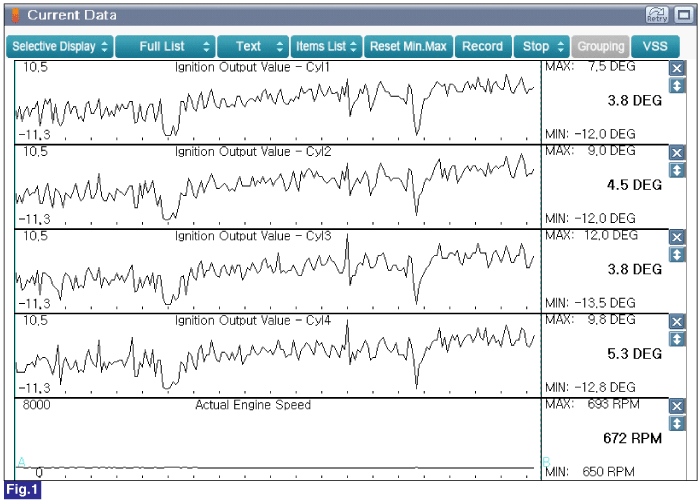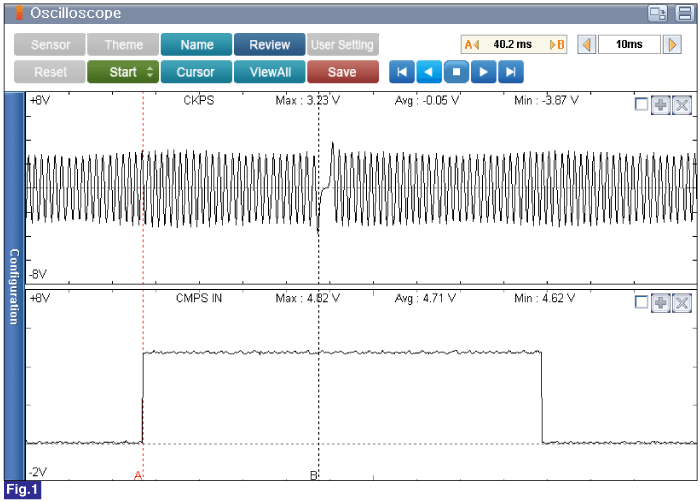Was a problem found in any of the above areas?

Fig.1) Engine Idle after Warm Up(Engine Sensor Status)
 | ▶ Repair or replace as necessary and go to "Verification of vehicle Repair" procedure. |
 | ▶ Go to "Timing Inspection" procedure. |
Visually/physically inspect for the following conditions.
- Vacuum hoses IN engine room for splits, kinks and improper installation.
- Positive crankcase ventilation valve for improper installation, damaged o-rings and malfunctioning.
- Verify that the ECM/PCM ground connections are clean and properly tightened.
Check MAPS and ECTS for the following conditions:
- contamination, deterioration, Poor connection or damaged harness.
- the MAP signal displayed on the GDS should increase as engine speed increases.
- the engine coolant temperature displayed on the GDS should close to the actual coolant temperature.
Was a problem found in any of the above areas?

Fig.1) Engine Idle after Warm Up(Engine Sensor Status)
 | ▶ Repair or replace as necessary and go to "Verification of vehicle Repair" procedure. |
 | ▶ Go to "Timing Inspection" procedure. |
IG KEY "OFF"
Connect VMI to GDS and select "Oscilloscope"
Connect Channel A positive probe to Pin No.2 (signal) and Channel A negative probe to Pin No.1 (signal) on the CKPS connector.
Connect Channel B positive probe to Pin No.3 (signal) terminal of CMPS harness connector and chassis ground.
Warm up the engine to normal operating temperature.

Fig.1) Normal waveforms of CKPS & CMPS(IN) at Engine idle.
A: CKPS & CMPS (intake side) syncronization - There are about 26~27 teeth between the CKPS missing tooth and CMPS signal.
Is the signal waveform normal?
 | ▶ Go to "Ignition System Inspection" procedure. |
 | ▶ Repair or readjust as necessary, check that the crankshaft and camshaft are correctly aligned the matching marks of the pulleys. Repair or readjust as necessary and go to "Verification of Vehicle Repair" procedure. |
Spark Plug Cable & Ignition Coil Inspection
Visually/physically inspect the spark plug cable and ignition coil related to the misfiring cylinder(s) for the following conditions.
- damage, cracks, carbon and flashover
- Poor connection or damaged harness
- Connected to the incorrect cylinders at the ignition coil and spark plug
Was a problem found in any of the above areas?
 | ▶ Repair or replace as necessary and go to "Verification of Vehicle Repair" procedure. |
 | ▶ Go to "Spark plug check" procedure. |
Spark plug check
Remove the spark plugs.
Visually/physically inspect the following items:
- Damaged insulation, Worn electrodes, Oil or fuel fouled, Loose terminals and cracks.
- Check for plug gap : 0.9 - 1.0 mm (0.035 - 0.039 in.)
- Check if the spark plug for the relevant cylinder is lighter in color than the other plugs.
Have any problems been found?
 | ▶ Repair or replace as necessary and go to "Verification of vehicle Repair" procedure. |
 | ▶ Go to "Fuel System Inspection" procedure. |
- Check the fuel for excessive water, alcohol, or other contaminants. Replace contaminated fuel as necessary.
- Install a fuel pressure gage.
- Inspect fuel pressure with normal idle status.
Specification : 338 ~ 348kPa(3.45~3.55kg/㎠, 49.02 ~ 50.47psi)
- Is fuel pressure within the specified value?
 | ▶ Go to "Fuel Pressure Hold Inspection" procedure. |
 | ▶ Inspect the suspected area. Refer to table as below. Repair or replace as necessary and go to "Verification of Vehicle Repair" procedure. |
Condition | Possible Cause | Suspected Area |
Fuel Pressure too low | Clogged fuel filter | Fuel filter |
Fuel leak on the fuel-pressure regulator that is assembled on fuel pump | Fuel Pump(Fuel Pressure Regulator) | |
Fuel Pressure too High | Sticking fuel pressure regulator | Fuel Pump(Fuel Pressure Regulator) |
Fuel Pressure Hold Inspection
- Stop the engine and check for a change in the fuel pressure gauge reading.
Specification : After engine stops, the gauge reading should hold for minimum 5 minutes
- Is fuel pressure within the specified value?
 | ▶ Go to "Compression pressure check" procedure. |
 | ▶ Inspect the suspected area. Refer to table as below. Repair or replace as necessary and go to "Verification of Vehicle Repair" procedure. |
Condition | Possible Cause | Suspected Area |
Fuel pressure drops slowly | Injector leak | Injector |
Fuel pressure drops immediately | Stuck open check valve of the fuel pump | Fuel pump |
Warm up the engine to normal operating temperature.
Remove the fuel pump fuse(15A).
Wait until the engine stopped.
Remove the ignition coils and spark plugs.
Crank the engine to remove any foreign material in the cylinders.
Put a compression pressure gauge into spark plug hole.
Check compression pressure at each cylinder.
Specification : Approx. 1,470kPa (15.0kgf/cm², 213psi)
Is compression pressure for each cylinder displayed within specifications?
 | ▶ Verify if the engine has excessive coolant consumption. If yes, check for damaged inlet water passage, engine block, cylinder head or head gasket. Repair or replace as necessary and go to "Verification of Vehicle Repair" procedure. |
 | ▶ If the cylinder compression in 1 or more cylinders is low, pour a small amount of engine oil into the cylinder through the spark plug hole and repeat compression test for cylinders with low compression pressure. - If adding oil helps the compression, it is likely that the piston rings and/or cylinder bore are worn or damaged. - If pressure stays low, a valve may be sticking or seating is improper, or there may be leakage past the gasket. Repair or replace as necessary and go to "Verification of Vehicle Repair" procedure. |